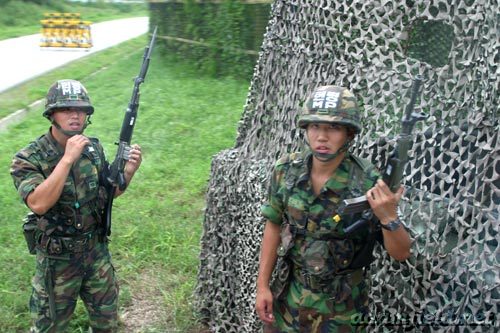
| [ Home ] | [ Photo Diary ] | [ Image Gallery ] | [ Contact Me ] |
My sister was visiting, so I planned a trip up to the DMZ with her and a couple of colleagues from school. We left for Seoul after work on Friday and slept in a rather expensive hotel. Rising early the next morning, we joined the group at the USO (United Service Organisation).
After a bus ride of about an hour, we arrived at the DMZ. We reached the first checkpoint and a young American soldier boarded the bus and checked out passports. Then we crossed a bridge that was covered in black and orange metal barricades in such a way as to deny anyone a straight run over the bridge. Over the bridge and down the road a little, we arrived at the UN command centre where we switched to two military busses.
 |
| Two bored guards pose next to their camouflaged post on a crossroad somewhere near the DMZ. |
Then it was onto the briefing, delivered at lightning speed by a US soldier. Then we signed a form to agree not to sue the UN if we got shot, not talk to the North Koreans, and not pull any funny faces or make gestures that could be used as propaganda; apparently the North records everything that goes on. I'm sure the South does aswell.
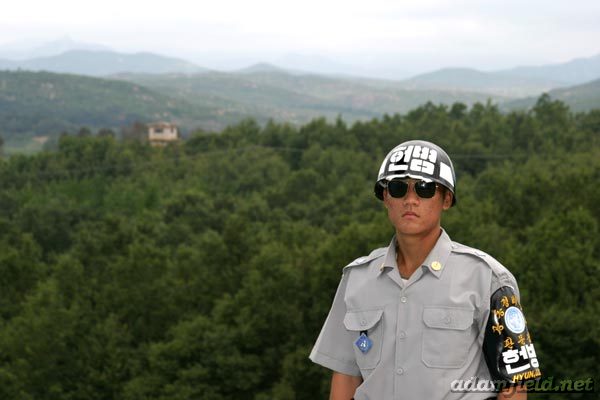 |
| A ROK soldier stands with a minefield and a North Korean observation post at his back. |
From there we rode the busses over another bridge and through three lines of defence. A barbed-wire fence with guard posts every two to three hundred meters, a minefield and an anti-tank wall that stretches the width of Korea. The fence had rocks stuck in it so that an enemy climbing the fence would disturb the rocks and leave an indication that something was up. We passed a couple of drab sandy coloured buildings with humvees parked outside. The American soldier guiding us informed us that this was the rapid reaction force, elite troops trained in infantry tactics. Their job is to be fully loaded, ready for battle, and in the JSA in 90 seconds, but their record time was 38 seconds! It took us longer than that to travel the 300 meters or so to the JSA.
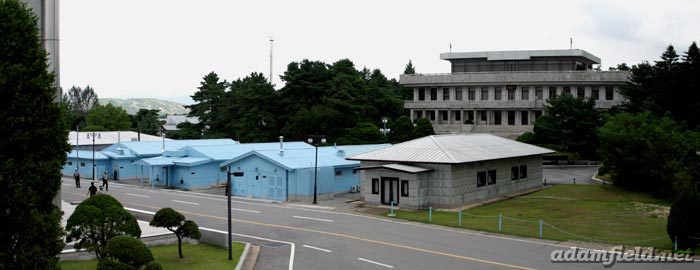 |
| The focal point of the North/South Dispute, the JSA appears tranquil and beautiful, with well-manicured lawns and artfully pruned trees. If this wasn't surrounded by tanks, bombs and barbed wire, it would be a perfect spot for a picnic. |
We exited the busses, and our first stop was the conference room. Located half and half in North and South Korea, the meeting room had a door to each country at either end, though the North Korean door was guarded to prevent us leaving that way. There was a large conference table in the exact centre, straddling the border. This is the table at which the never-ending armistice talks are still going on. Next to the Southern door there was a large picture of the flags of the UN members. This replaced a row of small silk flags that until a couple of months ago had adorned a shelf in that position. The flags were removed due to an incident that occurred when George Bush visited for talks. While the talks were in full swing, a North Korean soldier calmly removed the American flag from the shelf and proceeded to polish his boots with it.
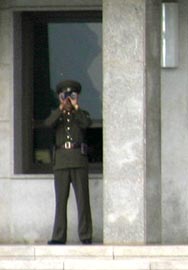 |
| A North Korean soldier keeps his eyes peeled from the visitors centre. |
After our visit to the conference room, we moved on to a small pagoda that commanded a great view of the area. We were given more history and background by our guide, then we got on the bus and headed over to a guard-post with a view of The Bridge of no Return and Propaganda Village.
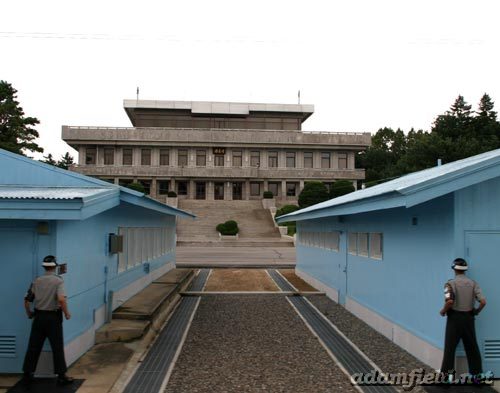 |
| Two ROK guards stand watching the North Korean visitor's centre, half exposed to the hail of bullets that would precede invasion from the crack infantry unit housed within. |
Located in the line-of-sight between the guard-post and the bridge of no return, there used to be a tree blocking good views of the bridge and its guard-post. Initial attempts to remove the tree were met with attacks by the North Koreans resulting in the deaths of two American soldiers (the "Axe Murder" incident). Operation 'Paul Bunyan' was then put into effect. A large number of troops and martial arts experts were mobilised to guard the 15 unarmed civilian engineers who cut down the tree. B52 bombers and attack helicopters were mobilised along the DMZ, and the carrier battle group Midway was stationed just off the coast. It cost $3.5 million to remove the tree.
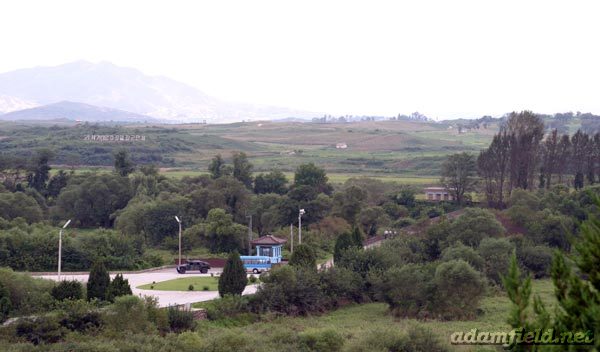 |
| Large white letters praising Kim Jon Il as the leader of the 21st century sit behind the bridge of no return. In the foreground, the memorial to the 'axe murder' incident can be seen; the site of the tree that cost $3.5 million to remove. |
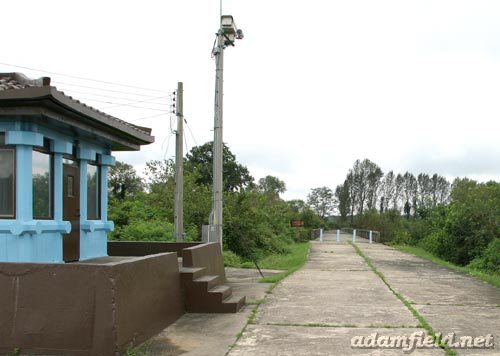 |
| The Bridge of No Return. After the Korean war, the prisoners of both sides were given the choice of going home or staying. Any who crossed the bridge could never go back to the other side. |
A good view was also afforded of the village of Gijongdong, the North Korean 'Peace Village'. The only people who ever enter this village is the 50 it takes to raise and lower the flags, and engineers who routinely carry out repairs on the unoccupied buildings. The South Korean 'Peace Village' is inhabited, but there's a strict 11pm curfew. They get compensated though, with a high tax-free income of $80,000 per year from their rice harvest, and $2.5 million for their ginseng (split between the 225 occupants of the village). You have to be a direct descendant of a villager to live in the village, and only women can marry into it.
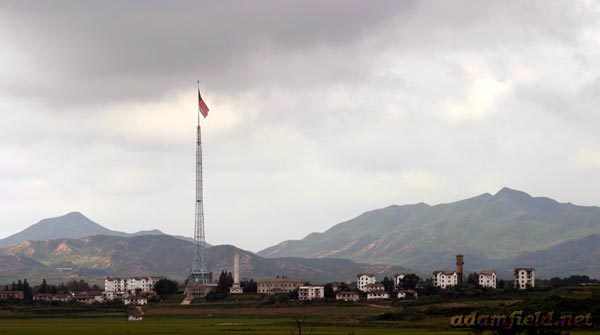 |
| At 160 meters, the flagpole in the North Korean town of Gijongdong is the tallest in the world. The flag measures 30 meters across and takes 50 men to raise it. The Americans call it propaganda village, for although it sprawls up the mountainside, no-one lives there. |
After lunch and a stop at the gift shop, we moved on to the third tunnel of aggression. This 2m wide, 2m high, 1.6 km long tunnel was intercepted on the South Korean side of the DMZ. Both the North and the South run tours of their side. Both also claim the other side dug it to attack them. I'm more believing of the south.
 |
| A buffet lunch was laid on in the 'Sanctuary Club', and the food was pretty good, though it reminded me of school dinners. |
 |
| What better way to remember your trip to the last frontier of the cold war than to buy a commemorative T-shirt or camouflaged bum-bag. |
We took a little train down and up, and walked to the first barrier that the South had erected. Barbed wired protected the heavy concrete (or perhaps metal) wall, and a video camera was pointed at it. The barrier had a door recessed into it and a small window to the other side. Photography within the tunnel was forbidden.
 |
| The entrance to the intercept tunnel that err.. intercepts the Third Tunnel of Aggression. |
Our final stop on the tour was Dora observatory. Photography was forbidden except behind the yellow line. I guess good shots of the DMZ are something they don't want tourists walking away with. The view was great though, and we could see right across the DMZ.
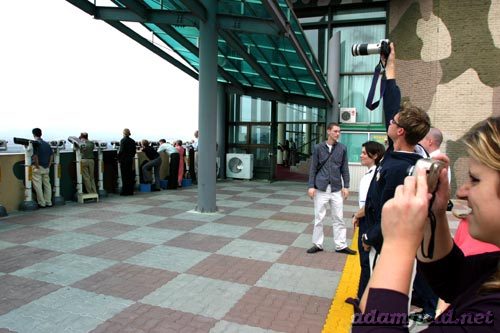 |
| Photographers strain to get good pictures of the DMZ from behind the yellow line at Dora Observatory. The ban on photography in front of the yellow line exists to ensure that photographers don't get good pictures of the DMZ. |
Returning home was smooth, though I was exhausted by then. I'd like to say it was the fear of being captured by the communists, but it probably had more to do with the beer I had drunk the night before.